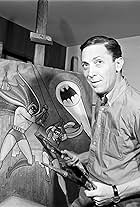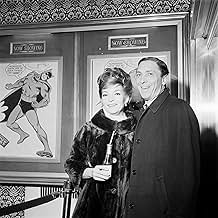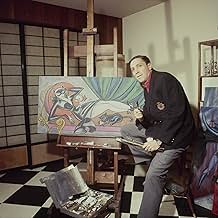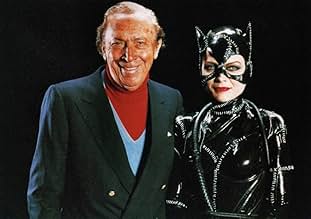Bob Kane(1915-1998)
- Writer
- Additional Crew
- Actor
Bob Kane was an American comic book writer and artist of Jewish descent, most famous for co-creating Batman and several members of Batman's supporting cast. Kane was inducted into the comic book industry's Jack Kirby Hall of Fame in 1994 and into the Will Eisner Comic Book Hall of Fame in 1996.
Kane was born under the name "Robert Kahn" in New York City. His father was the engraver Herman Kahn, and his mother was the housewife Augusta. Both of his parents were originally from Eastern Europe.
Kane attended DeWitt Clinton High School in the Bronx, where he was friends with future comic book writer Will Eisner. Following his graduation, he legally changed his name to "Robert Kane" and enrolled at the Cooper Union for the Advancement of Science and Art to study art. The school was a private college, located at Cooper Square on the border of the East Village neighborhood of Manhattan.
Kane originally wanted to become an animator, and in 1934 he was hired as a trainee animator by the animation studio Fleischer Studios (1921-1942), headed by the brothers Max Fleischer (1883-1972) and Dave Fleischer (1894-1979). He worked for up to two years in the production of animated short films, but had left the studio by 1936.
Kane entered the comics field in 1936, as a freelance penciler and inker. His early work was published in the magazine "Wow, What A Magazine!," which was edited by cartoonist Jerry Iger (1903-1990). Kane's most notable contribution was the comic serial "Hiram Hick", which he both drew and inked.
In 1936, Jerry Iger and.Will Eisner partnered to create their own company, "Eisner & Iger" (1936-1939). It was a comic book packager, producing complete comic stories that could be sold to publishers that did not have their own creative staff. In 1937, Kane was hired by this upstart company.
Kane's early work included the anthropomorphic animal series "Peter Pupp" (published by the magazine "Wags" in the United Kingdom and by Fiction House's "Jumbo Comics" in the United States), the comedy series "Ginger Snap" (published in "More Fun Comics" ), the comedy series "Oscar the Gumshoe" (published in "Detective Comics" ), the comedy series "Professor Doolittle" (published in "Adventure Comics" ), and the adventure series "Rusty and his Pals" (published in "Adventure Comics). Among them, Peter Pupp stood out for its" overtones of mystery and menace ".
By 1939, Superman had become a major hit for an early incarnation of DC Comics and there was a new market for comic book superheroes. Interested in creating his own superhero Kane started working on a new character, "Bat-Man". Kane said his influences for the character included actor Douglas Fairbanks' film portrayal of the swashbuckler Zorro; Leonardo da Vinci's diagram of the ornithopter, a flying machine with huge bat-like wings; and the 1930 film "The Bat Whispers", based on Mary Rinehart's mystery novel "The Circular Staircase" (1908).
Kane had already used Bill Finger as a ghost writer for his early comic strips. He asked Finger to provide additional ideas for Batman, and to write the initial Batman stories. Following a number of Finger's suggested redesigns, "Batman" debuted in "Detective Comics" #27 (May, 1939). It became a major hit for an early incarnation of DC Comics.
Early Batman stories were written and penciled by Bob Kane's own art studio (located in The New York Times building) and then sold for publication. Kane received the sole credit for whatever he and his staff created. Finger remained the main writer of the series, while Jerry Robinson (1922-2011) and George Roussos (1915-2000) were hired as Kane's art assistants. The four of them are jointly credited for introducing most of Batman's early supporting characters and memorable villains.
By the early 1940s, DC Comics demanded more Batman stories than the Bob Kane studio could produce. In response, DC hired its own writers and artists to work on additional stories, though Bob Kane continued to receive the sole credit for the stories. The most notable of these "ghost artists" was Dick Sprang (1915-2000) who remained attached to the Batman series for at least a decade, and co-created a popular new villain, the Riddler. Among the ghost writers of Batman, the most notable was Gardner Fox (1911-1986), who introduced some of Batman's notable equipment.
From 1943 to 1946, Bob Kane focused entirely on the Batman newspaper comic strip, and no longer produced new Batman stories for comic books. In his absence, Jerry Robinson became the main penciler for the Batman stories. Additional ghost artists of the period included Jack Burnley (1911-2006) and Win Mortimer (1919-1998). Several Batman-related covers were designed by Fred Ray (1920-2001), who was also the primary Superman cover-artist of the 1940s,
In 1946, the Batman newspaper comic strip ended, and Bob Kane started producing comic book stories for Batman again. He eventually hired his own ghost writers and ghost artists, The most notable among them were Lew Sayre Schwartz (1926-2011), the main artist of the Batman series between 1946 and 1953, and Sheldon Moldoff (1920-1967), the main artist of the series between 1953 and 1967. Schwartz is mainly remembered for co-creating a popular villain, called Deadshot. Moldoff is remembered for co-creating the villains Poison Ivy and Mr. Freeze, the second version of the villainous Clayface, Batman's allies Bat-Mite, Bat-Girl/Betty Kane, and Batwoman/Kathy Kane, and Batman's pet dog Ace the Bat-Hound.
In the 1960s, Kane found work in television animation., He created the television series "Courageous Cat and Minute Mouse" (1960-1962), featuring two anthropomorphic animal superheroes. Courageous Cat was a parody of Batman, while sidekick Minute Mouse was a parody of Robin. Kane subsequently created the television series "Cool McCool" (1966-1967), depicting the adventures of an inept secret agent.
In 1966 or 1967, Kane chose to retire from his work in comic books and animation. He was 52-years-old and had been working on the field for three decades. He started producing "fine art" works for exhibitions in galleries. His work as a painter was prolific, though comic book historians have noted that he again hired ghost artists to help him produce the paintings.
In 1989, Kane was hired as a consultant for the live-action "Batman" (1989) film directed by Tim Burton. He served in the same consulting role for its three sequels, released between 1992 and 1997. In 1998, Kane was hospitalized at Cedars-Sinai Medical Center in Los Angeles, where he eventually died. He was 83-years-old and had lived in retirement for two decades.
Kane was buried at Forest Lawn Memorial Park in the Hollywood Hills of Los Angeles. Several of the characters Kane created remain popular, and he continues to receive posthumous credit in works based on his creations.
Kane was born under the name "Robert Kahn" in New York City. His father was the engraver Herman Kahn, and his mother was the housewife Augusta. Both of his parents were originally from Eastern Europe.
Kane attended DeWitt Clinton High School in the Bronx, where he was friends with future comic book writer Will Eisner. Following his graduation, he legally changed his name to "Robert Kane" and enrolled at the Cooper Union for the Advancement of Science and Art to study art. The school was a private college, located at Cooper Square on the border of the East Village neighborhood of Manhattan.
Kane originally wanted to become an animator, and in 1934 he was hired as a trainee animator by the animation studio Fleischer Studios (1921-1942), headed by the brothers Max Fleischer (1883-1972) and Dave Fleischer (1894-1979). He worked for up to two years in the production of animated short films, but had left the studio by 1936.
Kane entered the comics field in 1936, as a freelance penciler and inker. His early work was published in the magazine "Wow, What A Magazine!," which was edited by cartoonist Jerry Iger (1903-1990). Kane's most notable contribution was the comic serial "Hiram Hick", which he both drew and inked.
In 1936, Jerry Iger and.Will Eisner partnered to create their own company, "Eisner & Iger" (1936-1939). It was a comic book packager, producing complete comic stories that could be sold to publishers that did not have their own creative staff. In 1937, Kane was hired by this upstart company.
Kane's early work included the anthropomorphic animal series "Peter Pupp" (published by the magazine "Wags" in the United Kingdom and by Fiction House's "Jumbo Comics" in the United States), the comedy series "Ginger Snap" (published in "More Fun Comics" ), the comedy series "Oscar the Gumshoe" (published in "Detective Comics" ), the comedy series "Professor Doolittle" (published in "Adventure Comics" ), and the adventure series "Rusty and his Pals" (published in "Adventure Comics). Among them, Peter Pupp stood out for its" overtones of mystery and menace ".
By 1939, Superman had become a major hit for an early incarnation of DC Comics and there was a new market for comic book superheroes. Interested in creating his own superhero Kane started working on a new character, "Bat-Man". Kane said his influences for the character included actor Douglas Fairbanks' film portrayal of the swashbuckler Zorro; Leonardo da Vinci's diagram of the ornithopter, a flying machine with huge bat-like wings; and the 1930 film "The Bat Whispers", based on Mary Rinehart's mystery novel "The Circular Staircase" (1908).
Kane had already used Bill Finger as a ghost writer for his early comic strips. He asked Finger to provide additional ideas for Batman, and to write the initial Batman stories. Following a number of Finger's suggested redesigns, "Batman" debuted in "Detective Comics" #27 (May, 1939). It became a major hit for an early incarnation of DC Comics.
Early Batman stories were written and penciled by Bob Kane's own art studio (located in The New York Times building) and then sold for publication. Kane received the sole credit for whatever he and his staff created. Finger remained the main writer of the series, while Jerry Robinson (1922-2011) and George Roussos (1915-2000) were hired as Kane's art assistants. The four of them are jointly credited for introducing most of Batman's early supporting characters and memorable villains.
By the early 1940s, DC Comics demanded more Batman stories than the Bob Kane studio could produce. In response, DC hired its own writers and artists to work on additional stories, though Bob Kane continued to receive the sole credit for the stories. The most notable of these "ghost artists" was Dick Sprang (1915-2000) who remained attached to the Batman series for at least a decade, and co-created a popular new villain, the Riddler. Among the ghost writers of Batman, the most notable was Gardner Fox (1911-1986), who introduced some of Batman's notable equipment.
From 1943 to 1946, Bob Kane focused entirely on the Batman newspaper comic strip, and no longer produced new Batman stories for comic books. In his absence, Jerry Robinson became the main penciler for the Batman stories. Additional ghost artists of the period included Jack Burnley (1911-2006) and Win Mortimer (1919-1998). Several Batman-related covers were designed by Fred Ray (1920-2001), who was also the primary Superman cover-artist of the 1940s,
In 1946, the Batman newspaper comic strip ended, and Bob Kane started producing comic book stories for Batman again. He eventually hired his own ghost writers and ghost artists, The most notable among them were Lew Sayre Schwartz (1926-2011), the main artist of the Batman series between 1946 and 1953, and Sheldon Moldoff (1920-1967), the main artist of the series between 1953 and 1967. Schwartz is mainly remembered for co-creating a popular villain, called Deadshot. Moldoff is remembered for co-creating the villains Poison Ivy and Mr. Freeze, the second version of the villainous Clayface, Batman's allies Bat-Mite, Bat-Girl/Betty Kane, and Batwoman/Kathy Kane, and Batman's pet dog Ace the Bat-Hound.
In the 1960s, Kane found work in television animation., He created the television series "Courageous Cat and Minute Mouse" (1960-1962), featuring two anthropomorphic animal superheroes. Courageous Cat was a parody of Batman, while sidekick Minute Mouse was a parody of Robin. Kane subsequently created the television series "Cool McCool" (1966-1967), depicting the adventures of an inept secret agent.
In 1966 or 1967, Kane chose to retire from his work in comic books and animation. He was 52-years-old and had been working on the field for three decades. He started producing "fine art" works for exhibitions in galleries. His work as a painter was prolific, though comic book historians have noted that he again hired ghost artists to help him produce the paintings.
In 1989, Kane was hired as a consultant for the live-action "Batman" (1989) film directed by Tim Burton. He served in the same consulting role for its three sequels, released between 1992 and 1997. In 1998, Kane was hospitalized at Cedars-Sinai Medical Center in Los Angeles, where he eventually died. He was 83-years-old and had lived in retirement for two decades.
Kane was buried at Forest Lawn Memorial Park in the Hollywood Hills of Los Angeles. Several of the characters Kane created remain popular, and he continues to receive posthumous credit in works based on his creations.





































